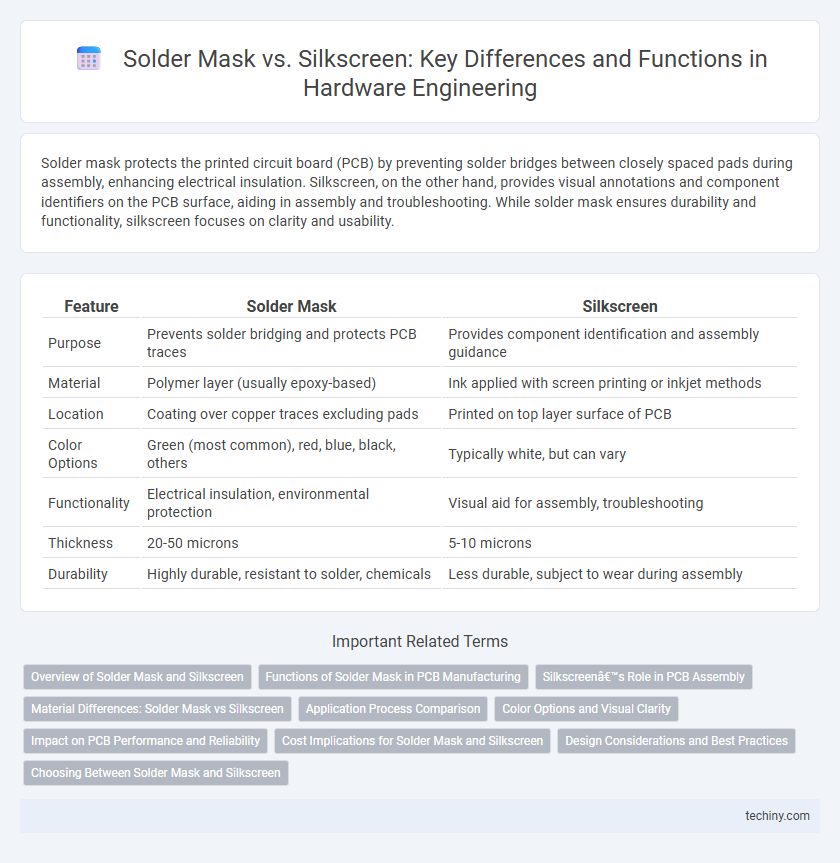Solder mask protects the printed circuit board (PCB) by preventing solder bridges between closely spaced pads during assembly, enhancing electrical insulation. Silkscreen, on the other hand, provides visual annotations and component identifiers on the PCB surface, aiding in assembly and troubleshooting. While solder mask ensures durability and functionality, silkscreen focuses on clarity and usability.
Table of Comparison
| Feature | Solder Mask | Silkscreen |
|---|---|---|
| Purpose | Prevents solder bridging and protects PCB traces | Provides component identification and assembly guidance |
| Material | Polymer layer (usually epoxy-based) | Ink applied with screen printing or inkjet methods |
| Location | Coating over copper traces excluding pads | Printed on top layer surface of PCB |
| Color Options | Green (most common), red, blue, black, others | Typically white, but can vary |
| Functionality | Electrical insulation, environmental protection | Visual aid for assembly, troubleshooting |
| Thickness | 20-50 microns | 5-10 microns |
| Durability | Highly durable, resistant to solder, chemicals | Less durable, subject to wear during assembly |
Overview of Solder Mask and Silkscreen
Solder mask is a protective layer applied to printed circuit boards (PCBs) that prevents solder bridging and protects copper traces from oxidation and environmental damage. Silkscreen is a layer of ink printed on top of the solder mask to provide reference designators, component outlines, and other markings for assembly and troubleshooting. Both layers are crucial in PCB manufacturing, enhancing durability and facilitating accurate component placement.
Functions of Solder Mask in PCB Manufacturing
The solder mask in PCB manufacturing functions primarily as a protective layer that prevents solder bridges by insulating the copper traces during the soldering process. It enhances electrical insulation and prevents oxidation, which ensures long-term reliability and performance of the PCB. Unlike silkscreen, the solder mask does not provide component labeling but focuses on safeguarding the circuitry and maintaining precise solder application.
Silkscreen’s Role in PCB Assembly
Silkscreen plays a crucial role in PCB assembly by providing clear, visible markings that identify component placement, reference designators, and polarity indicators on the board surface. Unlike the solder mask, which protects copper traces and prevents solder bridging, silkscreen enhances assembly accuracy and troubleshooting efficiency. High-quality silkscreen printing ensures proper component alignment and minimizes assembly errors, contributing to overall manufacturing reliability.
Material Differences: Solder Mask vs Silkscreen
Solder mask is a polymer layer made from epoxy or liquid photoimageable materials designed to insulate and protect PCB traces from oxidation and shorts, whereas silkscreen is typically composed of non-conductive ink applied to identify component locations and labels. The solder mask material exhibits high thermal and chemical resistance to withstand soldering processes, while silkscreen ink prioritizes readability and adhesion without requiring high heat tolerance. Manufacturing processes differ as solder mask requires precise UV curing and etching techniques, contrasting with silkscreen's simpler screen printing or inkjet application methods.
Application Process Comparison
Solder mask is applied through a photolithographic process where liquid polymer is spread and cured under UV light to protect PCB traces and prevent solder bridging during assembly. Silkscreen is typically applied using a screen printing technique that deposits ink on the PCB surface for labeling and component identification. While solder mask requires precise alignment to expose solder pads, silkscreen application focuses on clear legibility of printed text and symbols without impacting the electrical functionality.
Color Options and Visual Clarity
Solder mask typically comes in various colors such as green, blue, red, and black, providing excellent coverage that prevents solder bridging and protects the PCB surface. Silkscreen, usually applied in white or yellow, offers high visual clarity for component labels and reference designators, enhancing readability during assembly and troubleshooting. The contrast between solder mask and silkscreen colors is critical for maximizing visibility and ensuring precise component placement on printed circuit boards.
Impact on PCB Performance and Reliability
Solder mask significantly enhances PCB performance and reliability by preventing solder bridging, reducing corrosion, and protecting against environmental contaminants, thereby ensuring consistent electrical insulation and minimizing short circuits. Silkscreen, while primarily used for component identification and assembly guidance, indirectly supports reliability by aiding accurate placement and reducing assembly errors. The combination of solder mask's protective layer with silkscreen's visual clarity optimizes overall PCB durability and functionality in complex hardware engineering applications.
Cost Implications for Solder Mask and Silkscreen
Solder mask application typically incurs higher costs due to the precise layering and curing processes required to prevent solder bridging and protect PCB traces, which increases manufacturing time and material expenses. Silkscreen printing is generally more cost-effective as it involves simpler ink application techniques for labeling components, resulting in lower production complexity and quicker turnaround. Optimizing the balance between solder mask and silkscreen usage can significantly influence the overall PCB production budget, especially in high-volume hardware engineering projects.
Design Considerations and Best Practices
Solder mask plays a crucial role in preventing solder bridges and protecting copper traces from oxidation, requiring precise alignment during PCB design to avoid exposing pads or vias. Silkscreen enhances component identification and assembly by providing clear, legible markings, typically applied on non-solder mask areas to ensure visibility and durability. Optimal hardware engineering practices involve selecting solder mask colors for contrast with silkscreen layers and adhering to pad clearances, font sizes, and printing resolutions specified in IPC-7351 standards.
Choosing Between Solder Mask and Silkscreen
Choosing between solder mask and silkscreen depends on the specific requirements of the PCB design and manufacturing process. Solder mask provides essential protection against oxidation and solder bridging by covering exposed copper traces, while silkscreen offers critical visual information such as component labels, logos, and reference designators on the PCB surface. Prioritizing solder mask is crucial for electrical insulation and durability, whereas silkscreen enhances assembly accuracy and troubleshooting efficiency.
Solder mask vs Silkscreen Infographic

 techiny.com
techiny.com